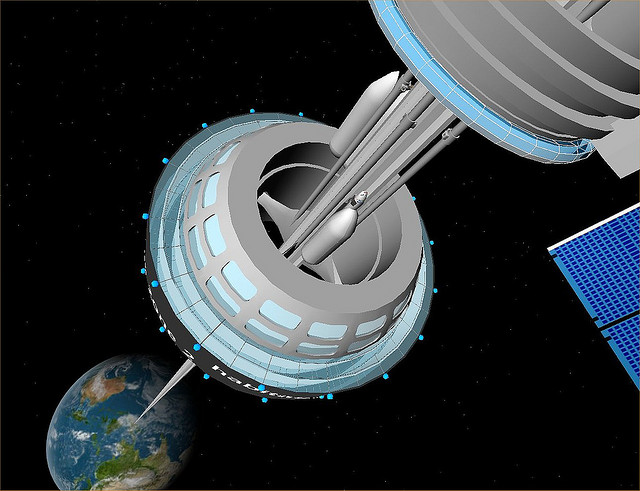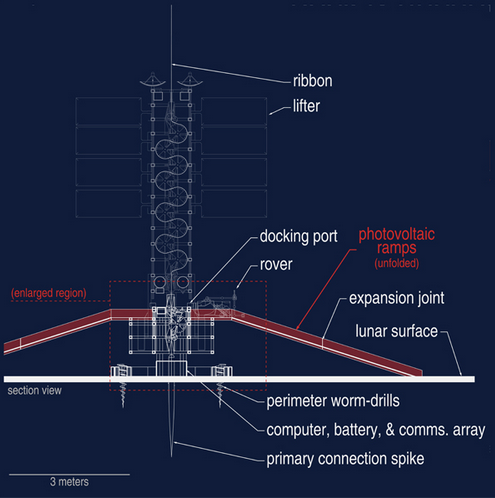Forget buying a stairway to heaven. Serious people are trying to build an elevator to space.
That’s not a metaphor, and yes, a space elevator sounds like plot point from an Arthur C. Clarke novel. Which makes sense, because it is. It’s a risky but well-considered plan to create a workable transit system between the ground and a set point outside the Earth’s atmosphere. But the space elevator isn’t only a mad-eyed Willy Wonka steampunk daydream. If some indefatigable elevator crusaders have their way, it will be ripped out of the annals of science fiction and safely constructed into reality.
A futuristic plan (that’s over 100 years old)
The idea is futuristic, but it’s also quite old: In 1895, Konstantin Tsiolkovsky, a rocket scientist in Russia, drew up an early proposal for a space elevator, and the basic concept remains unchanged. Enthusiasm for the endeavour has waxed and waned in the space exploration community over the years, but right now, a few high-profile projects are bringing the outlandish-sounding space elevator into focus again. They have captured the attention of documentarians as well as dreamers; feature-length films on elevator projects are in the works, like Shoot the Moon and Skyline: The Space Elevator Documentary.
The basic concept, in 1895 and still today, calls for an anchored cable stretching into space, capable of transporting people and things offworld. Tsiolkovsky imagined this tether anchored to Earth. Though the specifics of his design were totally impractical (he wanted the weight to be supported from below, while modern-day space elevator planners accept that it would need to be supported from above) the whole “tether from Earth reaching to space” thing is still the standard space elevator concept.
The most accepted plan today involves an anchor point on the Equator, with a tether extending around 100,000km above the Earth’s surface, where it would attach to a counterweight station and orbit with the planet.

Space elevator concept image via Flickr (CC BY 2.0)
The prospect has persisted for over a century partly because space elevator advocates see the contraption as a vital step towards expanding beyond our planet. Interplanetary transit, if it works, could eventually be a cost-effective alternative to rockets. Some theorize that since this alternative transport would drastically cut the expense of putting people and things into space, it could provide a way to eventually democratise space travel.
Today, that’s starting to look more crucial than ever. Hell, in a worst-case scenario, the elevator off Earth could be a potential escape route: Use in case of global apocalypse, a way to start colonizing other planets to prepare for disaster. In a best-case scenario, space elevators could be our ticket to feasibly expanding life beyond Earth and ferrying civilisation back and forth.
Living in a material world
But first we’d have to actually build it. Sceptics point out several extremely rational objections to the idea of creating a vertiginous, high-tech tower of Babel. While the concept may be logical, the number one hurdle is that there’s no material currently available that’s demonstrably strong enough for the job.
Even if such a material is invented soon — and we’re getting closer — it could also be vulnerable to vibrations. Wayward flocks of geese (towards the bottom) and space debris (towards the top) could smash into it. The machines transporting people and cargo could create too much wobble. Oh, and obviously, it’s going to be expensive as fuck to build, and there could be no money available to make it happen.
Accessing the right material remains the biggest problem. Many space elevator advocates, like physicist Bradley Edwards (who wrote a book called The Space Elevator in the 90s) believe that carbon nanofibers are a strong contender, since they are extremely lightweight but still resilient enough (they are more than 100 times stronger than steel). The problem is, no one has ever made a perfect version of the tube longer than a meter. That’s painfully short of 144,000 miles, the length NASA estimates a space elevator would be. The lack of available nanofibers is one of the reasons Google X halted its space elevator plans.

There may be another option: Penn State chemistry professor John Badding believes recently created tiny diamond nano-threads hold promise. That said, just because diamond nano-threads might work doesn’t mean there’s a manufacturer making it in the quantities that would be necessary for a gigantic tether to space.
Unless these materials become commonplace enough to be manufactured in large quantities, or the people building space elevators get enough money to manufacture it themselves, even proper materials may be too scarce and rare to get out elevator dreams off the ground.
A lot of smart people are looking up
The case against space elevators is easy to make, but the desire to build one persists. And the scientists working on the ambitious project aren’t a fringe freakfest of researchers: Google X recently developed plans to build a space elevator, and though the secret lab scrapped the project, it is clear the concept is a moonshot Google considers worthy of exploration.
NASA helped hold a contest to incentivise space elevator designs. Markus Landgraf, a mission analyst at the European Space Agency gave an impassioned TED talk about space elevators, arguing that they would transform space access from a dirt road to a highway. There’s an annual space elevator conference devoted to the idea, and in a big win for the “shit yeah this is actually possible” camp, earlier this year a team of experts assembled by the International Academy of Astronauts concluded that space elevators could totally happen.
Indeed, a few ambitious projects to ferry folks to space are in progress.

Art by Richard Bizley
Japanese construction juggernaut Obayashi says it will build a space elevator by 2050 capable of shuttling passengers 36,000km above earth, with an anchoring ‘earth port’ in the ocean. It will cost an estimated $US8 billion.
The venture is grandiose, and maybe more flourish than sense… but Obayashi is a huge corporation with money and power. There’s also a Japanese Space Elevator Association working to further projects like Obayashi’s. This is not something to ignore.
LiftPort, founded by former NASA contractor Michael Laine, is a much smaller space elevator operation, but also bold and potentially valuable. Unlike Obayashi, LiftPort doesn’t have a timeline for constructing a space elevator. After trying and failing to develop a space elevator in the early 2000s, they started from scratch with a new philosophy.
“Shoot the Moon”, a feature-length doc about LiftPort, is currently fundraising on Kickstarter.
The team is preparing for an experiment to send a robot roughly 7000m to prepare for what it would be like to put a space elevator on the moon. If they succeed, it will be the tallest structure in the world (and, I guess, out of it). It’s not going to be easy. The LiftPort team recently had to revamp their robot, which slowed down the project. It hasn’t found a site for the test. He’s aware that the projects that this test is preparing for will be “hellishly expensive.”

Laine remains doggedly optimist. “This robot that we’re building is an analogy. What we’re trying to understand is the mechanical process of climbing over distance and time under challenging conditions. We can’t expect to simulate a lunar elevator very well here on Earth,” he explained. “It’s really about understanding the problems. Once we finish this experiment, this is probably our last on-Earth experiment.”
“We’ll have pretty much learned all we can learn terrestrially,” Laine continued.
So LiftPort is basically getting ready to build a space elevator by getting ready for an experiment to inform them how to build a lunar elevator that could inform them how to build a space elevator, which isn’t exactly the most straightforward thing in the world. But Laine believes this thoroughness will pay off, and he has an enthusiastic team behind him who agree.
If this experiment is successful, they will begin plans to build a lunar elevator, anchored to the moon. This lunar elevator will, Laine hopes, serve both as a lower-gravity prototype for an Earth-based space elevator, and for its own benefits, like mining lunar helium and moon tourism. Lowered gravity, slower rotation, and zero atmosphere will make it a easier to build — though still grossly expensive.
But there’s still plenty of legit scepticism
Though some people pushing for space elevators are all-in, full-throttle believers, most people are, at the very least, heavy hedge-betters. Beyond all of the technical difficulties of actually building a space elevator, there’s legitimate concern from the community that there just isn’t the traffic to support the task — that they’d build the machine and it wouldn’t get used enough to make financial sense. As Ben Shelaf put it, a mechanical engineer and former CEO of Spaceward Foundations which researches space elevators, lunar elevator development is “looking for a solution to a nonexistent problem.”
A pressing reason to expedite the project (and a deep-pocketed corporation invested in that reason) could get the industrial production of the proper materials fast-tracked. But Laine made a great argument for why these moonshot (quite literally) projects are worthwhile even if they fail.
“The most valuable reason for doing this has nothing to do with space and everything to do with the spin-offs, with the technology we derive in the process of building these things,” he told me. “We developed a lot of great, world-class technology going to the moon. So here we are, a private company, for all intents and purposes, it’s an idea factory. We create new ideas, and all of those are focused around the concept of going to the moon, but we can take those ideas and commercialize them… You can make buckets of money and make the world a better place down here on Earth.”
Benjamin Ahr Harrison, the director of Shoot the Moon, is unabashed in his admiration for the space elevator community. “It’s this big kind of outsized idea, science-fictiony, and it’s amazing to watch them inspire people. People are willing to devote tons of time to help them with their project, because they want there to be a space elevator,” he told me.
What he did not tell me was whether he believed it could succeed; his documentary is more about the process and the team than seeing the goal met. But there is a reason for that. There’s an extremely good chance the goal will not be met in his lifetime.
Even if the lunar elevator experiment is an utter failure and Obayashi blows its deadline by 100 years, space elevators are a logical idea, and one worth paying attention. Some bad ideas sound decent in the beginning, like Joey, or the XFL. They start out with support, but it shrinks as the wrongness sets in. Meanwhile, some great ideas sound completely preposterous at first (like flight, or the electric lightbulb). The space elevator is one of those bonkers-but-brilliant ideas.
“The Space Elevator will be built about 50 years after everyone stops laughing,” Arthur C. Clarke famously wrote. There’s reason to admire the people who aren’t willing to wait that long.
Picture: Jim Cooke
